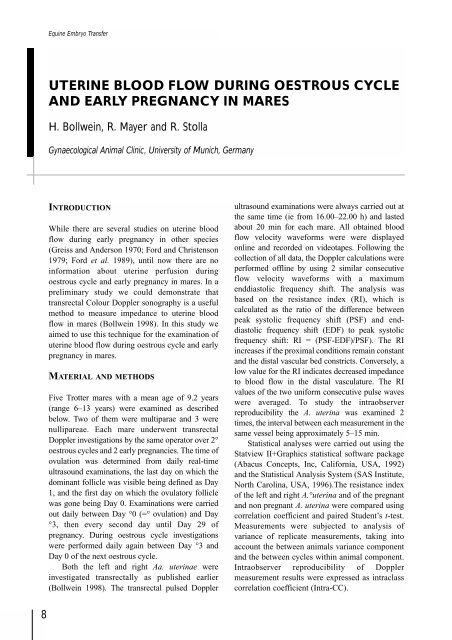Proceedings of the 5th International Symposium on EQUINE ...
Proceedings of the 5th International Symposium on EQUINE ...
Proceedings of the 5th International Symposium on EQUINE ...
- No tags were found...
You also want an ePaper? Increase the reach of your titles
YUMPU automatically turns print PDFs into web optimized ePapers that Google loves.
Equine Embryo TransferUTERINE BLOOD FLOW DURING OESTROUS CYCLEAND EARLY PREGNANCY IN MARESH. Bollwein, R. Mayer and R. StollaGynaecological Animal Clinic, University <str<strong>on</strong>g>of</str<strong>on</strong>g> Munich, GermanyINTRODUCTIONWhile <str<strong>on</strong>g>the</str<strong>on</strong>g>re are several studies <strong>on</strong> uterine bloodflow during early pregnancy in o<str<strong>on</strong>g>the</str<strong>on</strong>g>r species(Greiss and Anders<strong>on</strong> 1970; Ford and Christens<strong>on</strong>1979; Ford et al. 1989), until now <str<strong>on</strong>g>the</str<strong>on</strong>g>re are noinformati<strong>on</strong> about uterine perfusi<strong>on</strong> duringoestrous cycle and early pregnancy in mares. In apreliminary study we could dem<strong>on</strong>strate thattransrectal Colour Doppler s<strong>on</strong>ography is a usefulmethod to measure impedance to uterine bloodflow in mares (Bollwein 1998). In this study weaimed to use this technique for <str<strong>on</strong>g>the</str<strong>on</strong>g> examinati<strong>on</strong> <str<strong>on</strong>g>of</str<strong>on</strong>g>uterine blood flow during oestrous cycle and earlypregnancy in mares.MATERIALAND METHODSFive Trotter mares with a mean age <str<strong>on</strong>g>of</str<strong>on</strong>g> 9.2 years(range 6–13 years) were examined as describedbelow. Two <str<strong>on</strong>g>of</str<strong>on</strong>g> <str<strong>on</strong>g>the</str<strong>on</strong>g>m were multiparae and 3 werenullipareae. Each mare underwent transrectalDoppler investigati<strong>on</strong>s by <str<strong>on</strong>g>the</str<strong>on</strong>g> same operator over 2°oestrous cycles and 2 early pregnancies. The time <str<strong>on</strong>g>of</str<strong>on</strong>g>ovulati<strong>on</strong> was determined from daily real-timeultrasound examinati<strong>on</strong>s, <str<strong>on</strong>g>the</str<strong>on</strong>g> last day <strong>on</strong> which <str<strong>on</strong>g>the</str<strong>on</strong>g>dominant follicle was visible being defined as Day1, and <str<strong>on</strong>g>the</str<strong>on</strong>g> first day <strong>on</strong> which <str<strong>on</strong>g>the</str<strong>on</strong>g> ovulatory folliclewas g<strong>on</strong>e being Day 0. Examinati<strong>on</strong>s were carriedout daily between Day °0 (=° ovulati<strong>on</strong>) and Day°3, <str<strong>on</strong>g>the</str<strong>on</strong>g>n every sec<strong>on</strong>d day until Day 29 <str<strong>on</strong>g>of</str<strong>on</strong>g>pregnancy. During oestrous cycle investigati<strong>on</strong>swere performed daily again between Day °3 andDay 0 <str<strong>on</strong>g>of</str<strong>on</strong>g> <str<strong>on</strong>g>the</str<strong>on</strong>g> next oestrous cycle.Both <str<strong>on</strong>g>the</str<strong>on</strong>g> left and right Aa. uterinae wereinvestigated transrectally as published earlier(Bollwein 1998). The transrectal pulsed Dopplerultrasound examinati<strong>on</strong>s were always carried out at<str<strong>on</strong>g>the</str<strong>on</strong>g> same time (ie from 16.00–22.00 h) and lastedabout 20 min for each mare. All obtained bloodflow velocity waveforms were were displayed<strong>on</strong>line and recorded <strong>on</strong> videotapes. Following <str<strong>on</strong>g>the</str<strong>on</strong>g>collecti<strong>on</strong> <str<strong>on</strong>g>of</str<strong>on</strong>g> all data, <str<strong>on</strong>g>the</str<strong>on</strong>g> Doppler calculati<strong>on</strong>s wereperformed <str<strong>on</strong>g>of</str<strong>on</strong>g>fline by using 2 similar c<strong>on</strong>secutiveflow velocity waveforms with a maximumenddiastolic frequency shift. The analysis wasbased <strong>on</strong> <str<strong>on</strong>g>the</str<strong>on</strong>g> resistance index (RI), which iscalculated as <str<strong>on</strong>g>the</str<strong>on</strong>g> ratio <str<strong>on</strong>g>of</str<strong>on</strong>g> <str<strong>on</strong>g>the</str<strong>on</strong>g> difference betweenpeak systolic frequency shift (PSF) and enddiastolicfrequency shift (EDF) to peak systolicfrequency shift: RI = (PSF-EDF)/PSF). The RIincreases if <str<strong>on</strong>g>the</str<strong>on</strong>g> proximal c<strong>on</strong>diti<strong>on</strong>s remain c<strong>on</strong>stantand <str<strong>on</strong>g>the</str<strong>on</strong>g> distal vascular bed c<strong>on</strong>stricts. C<strong>on</strong>versely, alow value for <str<strong>on</strong>g>the</str<strong>on</strong>g> RI indicates decreased impedanceto blood flow in <str<strong>on</strong>g>the</str<strong>on</strong>g> distal vasculature. The RIvalues <str<strong>on</strong>g>of</str<strong>on</strong>g> <str<strong>on</strong>g>the</str<strong>on</strong>g> two uniform c<strong>on</strong>secutive pulse waveswere averaged. To study <str<strong>on</strong>g>the</str<strong>on</strong>g> intraobserverreproducibility <str<strong>on</strong>g>the</str<strong>on</strong>g> A. uterina was examined 2times, <str<strong>on</strong>g>the</str<strong>on</strong>g> interval between each measurement in <str<strong>on</strong>g>the</str<strong>on</strong>g>same vessel being approximately 5–15 min.Statistical analyses were carried out using <str<strong>on</strong>g>the</str<strong>on</strong>g>Statview II+Graphics statistical s<str<strong>on</strong>g>of</str<strong>on</strong>g>tware package(Abacus C<strong>on</strong>cepts, Inc, California, USA, 1992)and <str<strong>on</strong>g>the</str<strong>on</strong>g> Statistical Analysis System (SAS Institute,North Carolina, USA, 1996).The resistance index<str<strong>on</strong>g>of</str<strong>on</strong>g> <str<strong>on</strong>g>the</str<strong>on</strong>g> left and right A.°uterina and <str<strong>on</strong>g>of</str<strong>on</strong>g> <str<strong>on</strong>g>the</str<strong>on</strong>g> pregnantand n<strong>on</strong> pregnant A. uterina were compared usingcorrelati<strong>on</strong> coefficient and paired Student’s t-test.Measurements were subjected to analysis <str<strong>on</strong>g>of</str<strong>on</strong>g>variance <str<strong>on</strong>g>of</str<strong>on</strong>g> replicate measurements, taking intoaccount <str<strong>on</strong>g>the</str<strong>on</strong>g> between animals variance comp<strong>on</strong>entand <str<strong>on</strong>g>the</str<strong>on</strong>g> between cycles within animal comp<strong>on</strong>ent.Intraobserver reproducibility <str<strong>on</strong>g>of</str<strong>on</strong>g> Dopplermeasurement results were expressed as intraclasscorrelati<strong>on</strong> coefficient (Intra-CC).8








